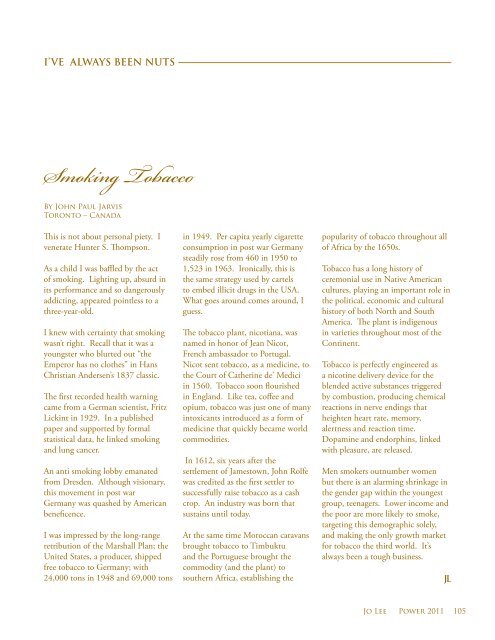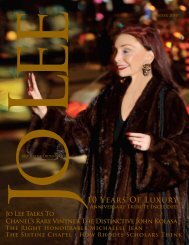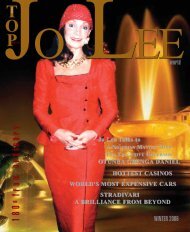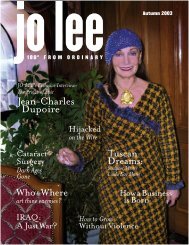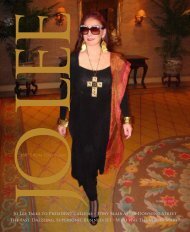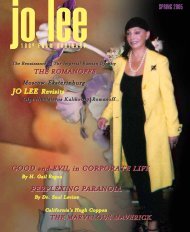Donna Saslove And Simon Lugassy - JO LEE Magazine
Donna Saslove And Simon Lugassy - JO LEE Magazine
Donna Saslove And Simon Lugassy - JO LEE Magazine
You also want an ePaper? Increase the reach of your titles
YUMPU automatically turns print PDFs into web optimized ePapers that Google loves.
I’VE ALWAYS BEEN NUTS<br />
Smoking Tobacco<br />
By John Paul Jarvis<br />
Toronto – Canada<br />
This is not about personal piety. I<br />
venerate Hunter S. Thompson.<br />
As a child I was baffled by the act<br />
of smoking. Lighting up, absurd in<br />
its performance and so dangerously<br />
addicting, appeared pointless to a<br />
three-year-old.<br />
I knew with certainty that smoking<br />
wasn’t right. Recall that it was a<br />
youngster who blurted out “the<br />
Emperor has no clothes” in Hans<br />
Christian <strong>And</strong>ersen’s 1837 classic.<br />
The first recorded health warning<br />
came from a German scientist, Fritz<br />
Lickint in 1929. In a published<br />
paper and supported by formal<br />
statistical data, he linked smoking<br />
and lung cancer.<br />
An anti smoking lobby emanated<br />
from Dresden. Although visionary,<br />
this movement in post war<br />
Germany was quashed by American<br />
beneficence.<br />
I was impressed by the long-range<br />
retribution of the Marshall Plan; the<br />
United States, a producer, shipped<br />
free tobacco to Germany; with<br />
24,000 tons in 1948 and 69,000 tons<br />
in 1949. Per capita yearly cigarette<br />
consumption in post war Germany<br />
steadily rose from 460 in 1950 to<br />
1,523 in 1963. Ironically, this is<br />
the same strategy used by cartels<br />
to embed illicit drugs in the USA.<br />
What goes around comes around, I<br />
guess.<br />
The tobacco plant, nicotiana, was<br />
named in honor of Jean Nicot,<br />
French ambassador to Portugal.<br />
Nicot sent tobacco, as a medicine, to<br />
the Court of Catherine de’ Medici<br />
in 1560. Tobacco soon flourished<br />
in England. Like tea, coffee and<br />
opium, tobacco was just one of many<br />
intoxicants introduced as a form of<br />
medicine that quickly became world<br />
commodities.<br />
In 1612, six years after the<br />
settlement of Jamestown, John Rolfe<br />
was credited as the first settler to<br />
successfully raise tobacco as a cash<br />
crop. An industry was born that<br />
sustains until today.<br />
At the same time Moroccan caravans<br />
brought tobacco to Timbuktu<br />
and the Portuguese brought the<br />
commodity (and the plant) to<br />
southern Africa, establishing the<br />
popularity of tobacco throughout all<br />
of Africa by the 1650s.<br />
Tobacco has a long history of<br />
ceremonial use in Native American<br />
cultures, playing an important role in<br />
the political, economic and cultural<br />
history of both North and South<br />
America. The plant is indigenous<br />
in varieties throughout most of the<br />
Continent.<br />
Tobacco is perfectly engineered as<br />
a nicotine delivery device for the<br />
blended active substances triggered<br />
by combustion, producing chemical<br />
reactions in nerve endings that<br />
heighten heart rate, memory,<br />
alertness and reaction time.<br />
Dopamine and endorphins, linked<br />
with pleasure, are released.<br />
Men smokers outnumber women<br />
but there is an alarming shrinkage in<br />
the gender gap within the youngest<br />
group, teenagers. Lower income and<br />
the poor are more likely to smoke,<br />
targeting this demographic solely,<br />
and making the only growth market<br />
for tobacco the third world. It’s<br />
always been a tough business.<br />
JL<br />
Jo Lee Power 2011 105


